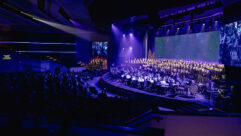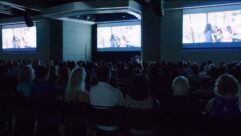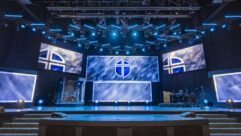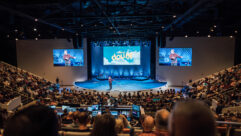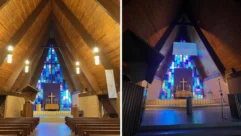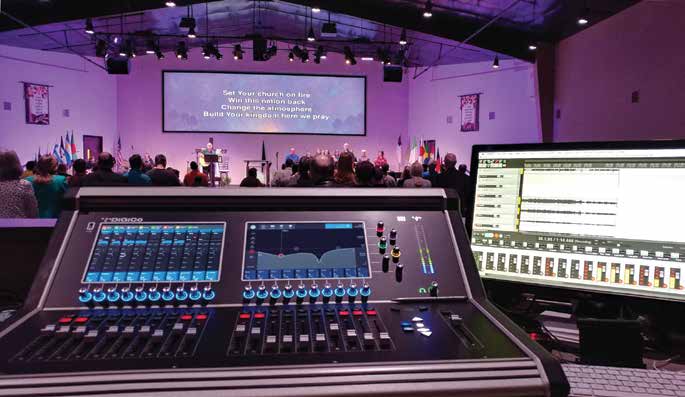

SVC: It looks like you got yourself a new DiGiCo mixer but before we get into the details on that I’m interested to know what your situation was with the church previous to the new equipment. What were you looking at and budgeting for?
Shawn Turner: The new mixer was brought up with the new building so we had to supply all the new AV equipment in the new building. Before we were running an old Mackie analog in our old sanctuary, our conditional sanctuary. And then we had a multipurpose gym that we were running a Presonus StudioLive board. So a little bit of mostly analog world but a little bit of digital touch with Presonus.
So you were all set to go digital on the house mixer.
Yes. We wanted to go digital.
I know there are numerous advantages to that especially in a tech volunteer environment where you can set something up, push one button and get right back to where you were with it.
That’s right. The recallability is very valuable in a digital world especially after events and then going back to a Sunday set.
And getting everything exactly back to the way it was and not having to write down or remember all the different settings. With a lot of tech volunteers, EQ knobs, for instance, only turn to the right.
Exactly. Most of my EQs have dips and no peaks.
This was part of a much bigger upgrade I believe. What else was involved with the project for new AV equipment for the church?
We were 100 percent new in the building so we got new video screen front and back and new speakers, new lighting system. We went with ColorSource for all the house lighting. We got RGB color mixing in the house as well as on stage so that gives a unique feel sometimes.
So this was a big, multi-dimensional project and that must have been a little tricky as far as spreading out the money and figuring how much was going to go where.
Oh, absolutely. It always comes back to that want versus need versus featureability of stuff. You know, instead of buying something that fits the budget, maybe we’ll spend more budget here and then take away there. When we did house lighting, we took away from auxiliary mics. It was real tricky. We had it all set until DiGiCo announced this new board and it came in the middle of a price point where we could make it stretch, but it had features that were on higher-end boards. So we swung for the fences on this and said: “Let’s see if we can make it work.”
Where did you see it demonstrated? Did they set up something in-house or did you see it at a trade show somewhere?
I saw it at NAB. They released it there and in Frankfurt simultaneously. And so it was a pre-release software. They had some glitches with it, but I saw the potential of it and I was really excited about it. So I talked to Matt, the Director of United States Sales at DiGiCo and he said yep, they’re supposed to be on board in June. I decided that’s the direction we needed to go.
So you went with the DiGiCo S21 and I know that the volunteers are probably excited to have something new to work on. Maybe a little apprehensive about going digital. So where did you buy the S21 and who did the installation?
We purchased it through Sight and Sound out of Colorado Springs, Colorado. Kris Johnson is our point of contact there, and he’s also the owner and integrator. I talked to him actually while I was still in Vegas and said, “hey, do you know about this?” He said, “yes, I was going to talk to you SVCONLINE.COM | JUNE 2017 | SVC 55 about it.” He started the balling rolling. We used an X32 rack mounting system because all our inputs were set up to go to a rackmounted D2 rack in the interim before this board was here.
And in addition to this, you got a LiveMix Personal Monitoring System from Digital Audio Labs?
Yeah. I saw the LiveMix. They speak Dante and that integrates into the system that we designed here perfectly—I can change all the input names and everything. At the time they were the only ones on the market doing it at this price point. You actually have the names of each channel that you’re adjusting. You can have dual adjustability and the units are stereo when you plug them in directly. So I was really excited about that.
It’s always great to be able to allow the musicians to handle their own monitor mix and set everything up just the way they want it.
Absolutely. You know, especially a seasoned musician. They know what they want to hear, what they need to hear. And they’re able to clean their mix up very efficiently without a lot of input.
And you have in-ear monitoring?
Yes. Yes. I’ve got an IM system, a Sennheiser system. And a couple of them are hardwired into the live mixes like the bass guitar and the electric and drums because they’re stationary positions. But everybody else has wireless IMs.
That gives everybody onstage a lot of freedom but it takes some getting used to if you’re coming from a floor wedge setup.
There is a difference, you know. All of a sudden it’s a closed-off sound that you’re not used to, and that’s another advantage of the LiveMix. You can actually a little bit of ambient mic to it to make it not sound so closed off. You can add reverb to each individual mix unit. And again you can do that at every mix unit for every person. Because a lot of people try to drop one ear and listen to the house, well then all you’re listening to is flash and your timing is off and it sounds like something is messed up. So with the ambient mic and the reverb capabilities it makes the transition from the live stage to in-ears a little easier.
And you equipped the sanctuary with Presonus StudioLive speakers.
We did. It was at the advice of Kris at Sight and Sound and in the grand scheme of things Presonus is a lower-end and they’re not really a speaker company. They do have some nice studio monitors though. I was really hesitant about it, but I’m really pleasantly surprised. I run an LRC in the room and the audio is really exceptionally clean. I looked at some different speakers but I was mainly looking for something that would speak Dante and have a redundancy and back up the analog just in case the network went down. So I was pleasantly surprised.
Once you have a Dante system in place why not add Dante speaking components?
Exactly. Dante is a beautiful system and beautifully simple and it just works. And it’s clean.
When you get all of this put together and the people all corralled, how many tech volunteers does it take to operate everything and how did they take to the S21?
Well normally we have somebody running the slides and the presentation words on the screen. We’ve got a lighting guy. We’re not running cameras right now. We’re set up for it. It’s just one of those things, need versus want in the budget. And then we’ve got one guy for audio. And sometimes I’m able to sit back and kind of oversee stuff – I’m mainly an audio guy. But our technical and our volunteer staff is exceptional. They love what they do. They see what they do as a ministry and not as a daunting job that they have to go to. Their hearts are into it.

So overall, how has the change from analog to digital gone so far?
The initial transition with the in-room board and the rack system was a little bit unnerving. We went to a complete iPad control system and there’s no tactile feel. And growing up in the audio world, or learning that route in the analog world, you learn to trust that tactile feel and it’s almost a safety blanket. It’s not necessary, it’s just a safety blanket. When going from that to the DiGiCo, we were trying to teach people the iPad interface versus trying to teach people the DiGiCo interface, especially when you go to an individual channel layout. Even with the newest firmware update you can actually see when you engage a gate or a compressor or even engage an insert if you had effects or EQ, it shows the route and it’s laid out exactly the way the channel flow is and you can transition somebody from an analog. Okay, here’s your gain knob. Everything is global from there. You can come down on a channel strip and this is left to right. It’s real easy for a lot of my older volunteers to understand how the signal flows.
Yes, it’s not all the sound. There has always been some feel to it with the analog systems. Depends on how you want to go and every church has its own personality.
Absolutely. And I’ve used several digital boards throughout my years and this one is very in tune with the transition from analog, because of the price point. I was a little hesitant about it because the SD series can be a little overwhelming to somebody who is just jumping into a digital board, but the software is very good on this.
And how do you use the Flexi channel design on it?
The Flexi channel works great in this environment. Since I’m shooting a stereo imaged room, whenever I add something that’s stereo I could just eat up one processing channel. I don’t have to eat up two. Some people are hesitant because this is only a 40 processing channel board. But I’m not using all 40 channels and actually I’m using more than 40 channels because of the Flexi channels. I’ve got three computers running into it, an auxiliary, a stage input for remote presentation. I’ve actually had the choir mics in stereo image also. So when you look at the choir, if you see somebody on the left side of the choir singing, you hear them on the left side of the room. As an audio guy you kind of geek out about it because you’re able to stereo image the room really well with the Flexi channel. And I can pan left and right.
You’ve got live music and a choir there. How do you do a recording of the services? Do you usually record those?
Yeah, we record them. The DiGiCo S21 also has the UB90, which is their output for USB. It can go up to 48K for 48 channels, so a sampling rate of 48 channels. And I’m using a program called Reaper and I’m able to record those channels pre-fader. Everything just comes in as raw signal. So I can actually dump that signal back into the board and hit “listen to sources” on the board and it changes all the inputs on the board to listen to that USB channel. And I can do live sound check. I can do training. I can mess the EQing up and say what’s wrong with this mix and it’s an awesome, awesome training tool. And then here you go again, the advantage of a digital board. When we’re done training I reload the scene that we just had before and it fixes everything. Nothing is messed up permanently. I don’t have to spend hours tweaking knobs or getting things back the way they were.
And clean the blood off the board where you’ve got some beginners.
That’s right. And one aspect we’ve also used with the record, we traditionally do a rehearsal and not everybody is able to make it to the rehearsal. So I can record the rehearsal and with the LiveMix being Dante I can actually play back the rehearsal and make their channel live so they can play along, they can sing along, they can hear all the cues, everything else I talked about, just like if everybody was here. Now I’ve used it kind of uniquely, but it’s worked really well for people who can’t make a rehearsal.
Do you have that out in the center of the house or up in the balcony somewhere?
No, the board is actually in the center. We don’t have a balcony. It’s a smaller venue. It’s only a 500-seat auditorium so it’s kind of intimate. That enables me to get the LRC in here without any phasing issues and I’m out probably 12-foot off the back wall and into the room just a little bit; same level.
Well, you’ve got it in a good place. Sometimes they stick those mixers in a room off to the side of the balcony and it can be a real challenge to hear what’s going on.
Yeah. I was actually on the committee when we built this building and my input was very adamant about the need to not put the soundboard in a hole because it will affect us long term.
How do you mic everything? What kind of mics do you use for the services?
I use Audix mics for choir. I’ve got Audix drum kits. I’ve got DPA head-worn mics. I love DPA stuff and just can’t afford it across the board. That’s one of the things that had to get cut when we were looking at the DiGiCo. But I went with Sennheiser mics. So the mics I’m using for the vocals are the E945s and I really like those. They’re open sound. For the wireless I’m running the Shure and I’m running the ULXD, which we spent a little bit more money on, but I had to let our committee know that this money was well spent. You don’t have to wait for the mic to come on. It’s on instantly. And also it integrates seamlessly with the Dante system. In fact over Christmas we had a performance in here and I rented eight more channels of the ULXD and all I had to do was plug into our receiver array for the wireless and then plug a CAT-5 in. So I had two coax and one CAT-5 and two powers and I was done. I just rerouted it on the Dante, selected the inputs and copied my existing EQs for the wireless and I was done.
I notice you’ve got a huge center video display upstage. What kind of display is that?
Well that is a blended dual 16 x 10 screen- -I’m shooting two Sony 7,000 lumens laser projectors. And I’ve been really happy with them. The blend is really good and it’s really bright and punchy and able to penetrate the light on the stage. Actually when we have intimate settings, like a candlelight service or something that’s a little darker scene, I actually have to turn the brightness down on those projectors. Normally you’re always turning the brightness up or turning the contrast and trying to get the sharpness right where the words pop. But this is really nice. It’s worked really well as a backscape for scenery and stuff.
You put song lyrics on it?
We use ProPresenter for the words and we use ProVideoPlayer, that’s another product that Renewed Vision provides and basically it’s a layering system. I can put layers on the one large canvas, keyholes; I can add things in the corner; I can add layers to it, move things around. It basically just enables me to paint the canvas with any information on it we like.
And there are events going on in there other than Sunday services?
Yeah. We’ll have events time to time. You know, all your traditional church stuff— weddings, funerals, special events during holidays and Easter. And then we also will bring in guest speakers, or guest comedians to try to bring in the community. We’ve also had a couple of community events to try to welcome the community to use our facilities. We’ve partnered with one of the local schools and they actually have their conferences and their teacher in-services at our facilities to able to further engulf being part of the community and not just be in the church that’s just around the corner.
The next time they give you some funding for improvements, which direction will you go with the new gear then?
My lighting guy will tell me that I need to get some lights since I cut some of the lights from the budget to get the S21. So I think what we’ll do is get some moving lights in here to be able to scene-scape the thing. I would also —and I’ve rented it before— I would also like to integrate environmental projection in the room. I think that adds a neat feel. And then after that I’ll probably expand the wireless and go ahead and purchase ULXDs so we don’t have to rent every time.


